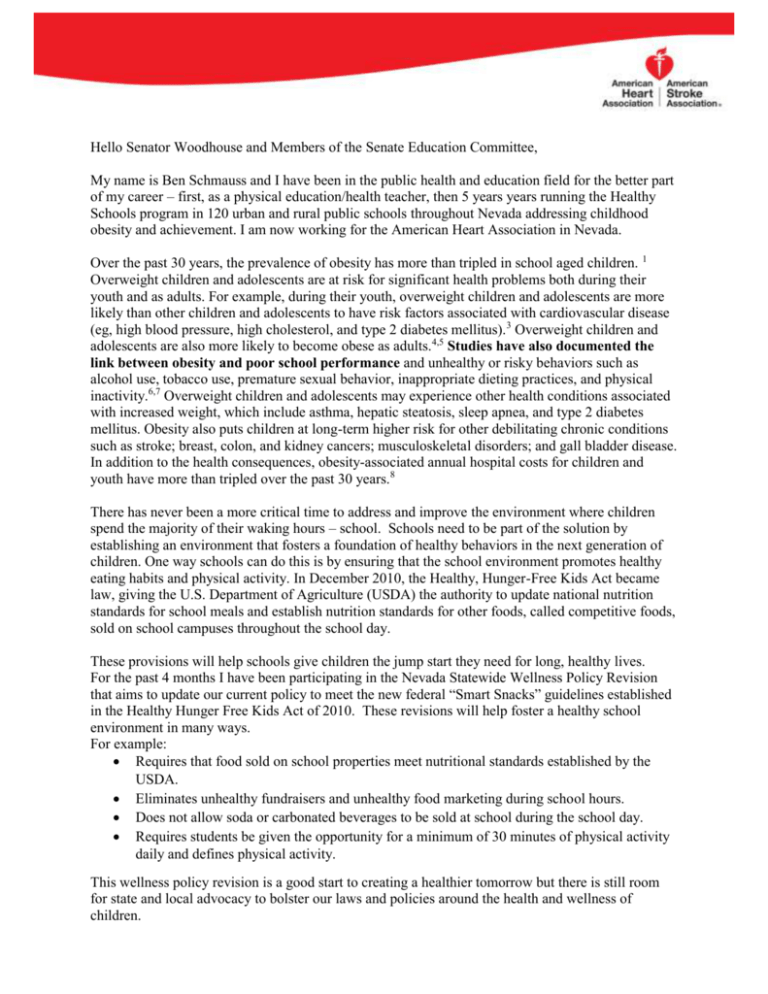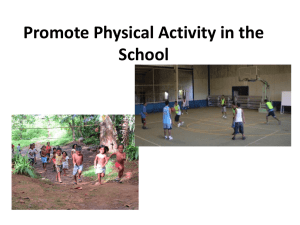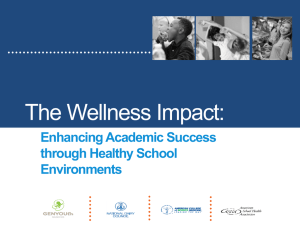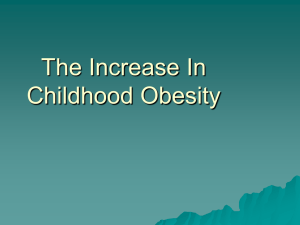Agenda Item X - Written Testimony from Ben Schmauss, American
advertisement

Hello Senator Woodhouse and Members of the Senate Education Committee, My name is Ben Schmauss and I have been in the public health and education field for the better part of my career – first, as a physical education/health teacher, then 5 years years running the Healthy Schools program in 120 urban and rural public schools throughout Nevada addressing childhood obesity and achievement. I am now working for the American Heart Association in Nevada. Over the past 30 years, the prevalence of obesity has more than tripled in school aged children. 1 Overweight children and adolescents are at risk for significant health problems both during their youth and as adults. For example, during their youth, overweight children and adolescents are more likely than other children and adolescents to have risk factors associated with cardiovascular disease (eg, high blood pressure, high cholesterol, and type 2 diabetes mellitus).3 Overweight children and adolescents are also more likely to become obese as adults.4,5 Studies have also documented the link between obesity and poor school performance and unhealthy or risky behaviors such as alcohol use, tobacco use, premature sexual behavior, inappropriate dieting practices, and physical inactivity.6,7 Overweight children and adolescents may experience other health conditions associated with increased weight, which include asthma, hepatic steatosis, sleep apnea, and type 2 diabetes mellitus. Obesity also puts children at long-term higher risk for other debilitating chronic conditions such as stroke; breast, colon, and kidney cancers; musculoskeletal disorders; and gall bladder disease. In addition to the health consequences, obesity-associated annual hospital costs for children and youth have more than tripled over the past 30 years.8 There has never been a more critical time to address and improve the environment where children spend the majority of their waking hours – school. Schools need to be part of the solution by establishing an environment that fosters a foundation of healthy behaviors in the next generation of children. One way schools can do this is by ensuring that the school environment promotes healthy eating habits and physical activity. In December 2010, the Healthy, Hunger-Free Kids Act became law, giving the U.S. Department of Agriculture (USDA) the authority to update national nutrition standards for school meals and establish nutrition standards for other foods, called competitive foods, sold on school campuses throughout the school day. These provisions will help schools give children the jump start they need for long, healthy lives. For the past 4 months I have been participating in the Nevada Statewide Wellness Policy Revision that aims to update our current policy to meet the new federal “Smart Snacks” guidelines established in the Healthy Hunger Free Kids Act of 2010. These revisions will help foster a healthy school environment in many ways. For example: Requires that food sold on school properties meet nutritional standards established by the USDA. Eliminates unhealthy fundraisers and unhealthy food marketing during school hours. Does not allow soda or carbonated beverages to be sold at school during the school day. Requires students be given the opportunity for a minimum of 30 minutes of physical activity daily and defines physical activity. This wellness policy revision is a good start to creating a healthier tomorrow but there is still room for state and local advocacy to bolster our laws and policies around the health and wellness of children. Over the previous 9 years that Nevada has had a wellness policy implementation and enforcement around wellness in schools and the wellness policy has varied greatly. A few school districts and district leaders have stepped up and created cultures that promote wellness as part of a high achieving learning environment while others have done next to nothing. When some leaders hear about violations to the policy they do nothing because no one is “measuring them on that outcome”. We need to make physical activity and nutrition part of the solution to our academic struggles in Nevada. We need schools and districts to step up and create the type of environment where teachers, parents and community members know that healthy kids learn better, live longer and our schools will not be the enablers of food and fitness habits that do not lead to learning or health. As legislators I am asking you today to commit to keeping this issue as a priority. In the education world there is a saying “what gets measured, gets done”. Historically the districts have not had to account to anyone on this issue and because of that the wellness policy has not been enforced. The main concern that came up in our group of 20+ task force members on the 4 month revision of this policy is that we would create this policy and it would be implemented and enforced the same way the previous policy was. On a scale of 1 -10 ten being the highest I would say the wellness policy was implemented at a 4. Help us create a culture of accountability in Nevada! Thank You. New Nevada Wellness Policy (Click on Nevada Wellness Policy) http://nutrition.nv.gov/ AHA School Nutrition Fact Sheet http://www.heart.org/idc/groups/heartpublic/@wcm/@adv/documents/downloadable/ucm_301787.pdf Healthy Hunger Free Kids Act of 2010 http://www.fns.usda.gov/school-meals/healthy-hunger-free-kids-act References 1. Progress in Preventing Childhood Obesity: How Do We Measure Up? Washington, DC. Institute of Medicine Report Brief. September 2006. Available at: http://www.iom.edu/Object.File/Master/36/984/11722_reportbrief.pdf. Accessed January 7, 2008. 2. Overweight and Obesity. Atlanta, Ga: Centers for Disease Control and Prevention, US Department of Health & Human Services. Available at: http://www.cdc.gov/nccdphp/dnpa/obesity/index.htm. Accessed January7, 2008. 3. Freedman DS, Dietz WH, Srinivasan SR, Berenson GS. The relation of overweight to cardiovascular risk factors among children and adolescents: the Bogalusa Heart Study. Pediatrics. 1999;103:1175–1182. 4. Whitaker RC, Wright JA, Pepe MS, Seidel KD, Dietz WH. Predicting obesity in young adulthood from childhood and parental obesity. N EnglJ Med. 1997;337:869–873. 5. Serdula MK, Ivery D, Coates RJ, Freedman DS. Williamson DF, Byers T. Do obese children become obese adults? A review of the literature. Prev Med. 1993;22:167–177. 6. Miller JW, Naimi TS, Brewer RD, Jones SE. Binge drinking and associated health risk behaviors among high school students. Pediatrics. 2007;119:76–85. 7. Neumark-Sztainer D, Story M, French SA, Resnick MD. Psychosocial correlates of health compromising behaviors among adolescents. Health Educ Res. 1997;12:37–52. 8. Overview of the IOM’s Childhood Obesity Prevention Study: Fact Sheet.Washington, DC: Institute of Medicine of the National Academies;September 2004. Benjamin Schmauss , 4445 South Jones Blvd, Suite 1B ,Las Vegas, NV 89103, (702) 408-4208, Ben.Schmauss@heart.org 2 7/15/2014









